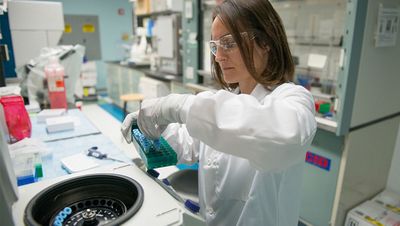In October 2006, Craig Mello received a strange phone call from Sweden at 4:30 a.m. The voice at the other end of the line told him to get dressed and that his life was about to change.
"We think this could be effective in [the early] phase, helping the body clear the virus and preventing progression to that severe hyperimmune response which occurs in some patients."
Shortly afterwards, he was informed that along with his colleague Andrew Fire, he had won the Nobel Prize in Physiology or Medicine.
Eight years earlier, biologists Fire and Mello had made a landmark discovery in the history of genetics. In a series of experiments conducted in worms, they had revealed an ancient evolutionary mechanism present in all animals that allows RNA – the structures within our cells that take genetic information from DNA and use it to make proteins – to selectively switch off genes.
At the time, scientists heralded the dawn of a new field of medical research utilizing this mechanism, known as RNA interference or RNAi, to tackle rare genetic diseases and deactivate viruses. Now, 14 years later, the pharmaceutical company Alnylam — which has pioneered the development of RNAi-based treatments over the past decade — is looking to use it to develop a groundbreaking drug for the virus that causes COVID-19.
"We can design small interfering RNAs to target regions of the viral genome and bind to them," said Akin Akinc, who manages several of Alnylam's drug development programs. "What we're learning about COVID-19 is that there's an early phase where there's lots of viral replication and a high viral load. We think this could be effective in that phase, helping the body clear the virus and preventing progression to that severe hyperimmune response which occurs in some patients."
Called ALN-COV, Alnylam's treatment hypothetically works by switching off a key gene in the virus, inhibiting its ability to replicate itself. In order to deliver it to the epithelial cells deep in the lung tissue, where the virus resides, patients will inhale a fine mist containing the RNAi molecules mixed in a saline solution, using a nebulizer.
But before human trials of the drug can begin, the company needs to convince regulators that it is both safe and effective in a series of preclinical trials. While early results appear promising - when mixed with the virus in a test tube, the drug displayed a 95 percent inhibition rate – experts are reserving judgment until it performs in clinical trials.
"If successful this could be a very important milestone in the development of RNAi therapies, but virus infections are very complicated and it can be hard to predict whether a given level of inhibition in cell culture will be sufficient to have a significant impact on the course of the infection," said Si-Ping Han, who researches RNAi therapeutics at California Institute of Technology and is not involved in the development of this drug.
So far, Alnylam has had success in using RNAi to treat rare genetic diseases. It currently has treatments licensed for Hereditary ATTR Amyloidosis and Acute Hepatic Porphyria. Another treatment, for Primary Hyperoxaluria Type 1, is currently under regulatory review. But its only previous attempt to use RNAi to tackle a respiratory infection was a failed effort to develop a drug for respiratory syncytial virus (RSV) almost a decade ago.
However, the technology has advanced considerably since then. "Back then, RNAi drugs had no chemical modifications whatsoever, so they were readily degraded by the body, and they could also result in unintended immune stimulation," said Akinc. "Since then, we've learned how to chemically modify our RNAi's to make them immunosilent and give them improved potency, stability, and duration of action."
"It would be a very important milestone in the development of RNAi therapies."
But one key challenge the company will face is the sheer speed at which viruses evolve, meaning they can become drug-resistant very quickly. Scientists predict that Alnylam will ultimately have to develop a series of RNAi drugs for the coronavirus that work together.
"There's been considerable interest in using RNAi to treat viral infections, as RNA therapies can be developed more rapidly than protein therapies like monoclonal antibodies, since one only needs to know the viral genome sequence to begin to design them," said David Schaffer, professor of bioengineering at University of California, Berkeley. "But viruses can evolve their sequences rapidly around single drugs so it is likely that a combinatorial RNAi therapy may be needed."
In the meantime, Alnylam is conducting further preclinical trials over the summer and fall, with the aim of launching testing in human volunteers by the end of this year -- an ambitious aim that would represent a breakneck pace for a drug development program.
If the approach does ultimately succeed, it would represent a major breakthrough for the field as a whole, potentially opening the door to a whole new wave of RNAi treatments for different lung infections and diseases.
"It would be a very important milestone in the development of RNAi therapies," said Han, the Caltech researcher. "It would be both the first time that an RNAi drug has been successfully used to treat a respiratory infection and as far as I know, the first time that one has been successful in treating any disease in the lungs. RNAi is a platform that can be reconfigured to hit different targets, and so once the first drug has been developed, we can expect a rapid flow of variants targeting other respiratory infections or other lung diseases."
